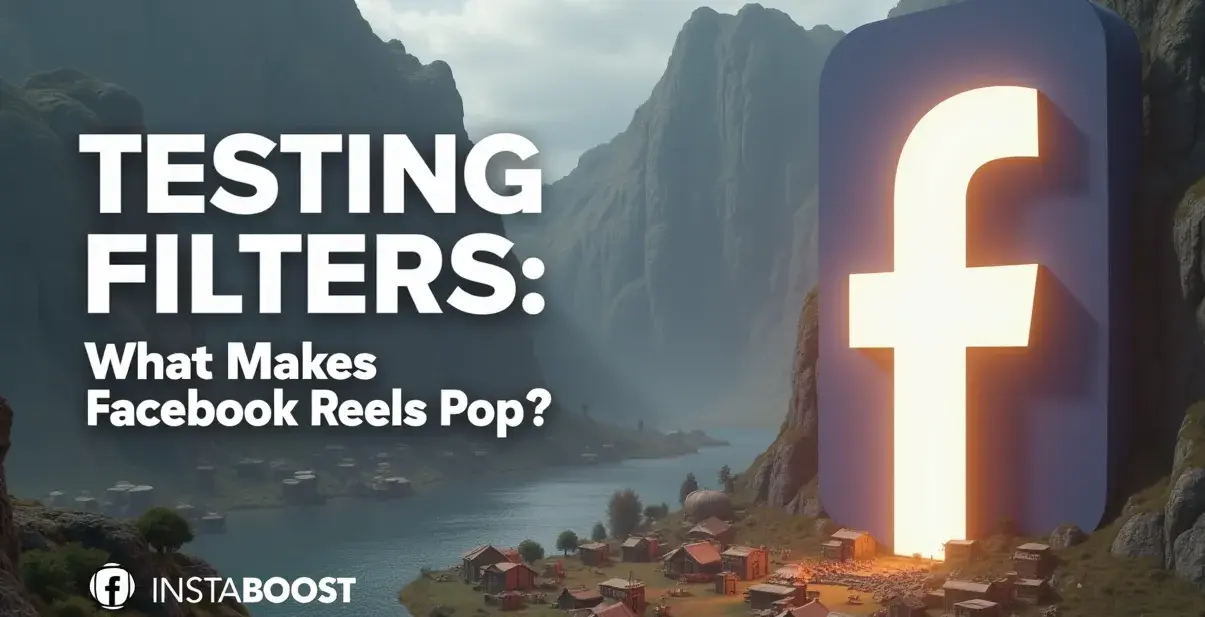What Makes Facebook Reels Filters Truly Pop?
Standout Facebook Reels filters combine creative experimentation with clear visual impact. Creators test variations to see which treatments enhance motion, color, and subject focus, then iterate on what draws attention quickly. Filters that sharpen contrast, guide the eye, or reinforce a narrative tend to perform better, while overdone effects can distract when misused. A smart path is to align the filter with the story, preview on multiple clips, and keep what boosts clarity and appeal.
The Science Behind Standout Facebook Reels
When you spend some time watching Facebook Reels, you start to notice that while most videos blend together, a handful will make you stop and pay attention right away. And it’s not always because someone is doing something wild or the video quality is perfect. Lately, it seems like these videos stand out mostly because of how filters are used. Picking the right filter isn’t just about hiding imperfections or making things look polished. It actually changes the way the video feels and even how people react to it. Sometimes a filter shifts the mood, or makes you focus on a certain color, or gives the whole thing a particular atmosphere that matches what the creator is going for.
In a feed where everyone is hoping to get noticed, filters can become this quiet way creators communicate, whether they realize it or not. Since Facebook’s algorithm pays attention to which videos make people pause or interact, using filters thoughtfully can make a real difference. A lot of creators now try out different filters on the same video, almost the way companies test different ads, to see which one gets more engagement.
So, figuring out what makes someone stop scrolling isn’t just about writing a catchy caption or using the right hashtag anymore. For brands like INSTABOOST, and anyone trying to keep up with all the changes on social media, understanding how filters actually influence people is starting to matter more than you’d expect.
Sometimes it’s those subtle choices – like picking a mood or learning how to make your Facebook stand out – that end up shaping what people remember. It’s interesting to see how something as simple as a filter can quietly shape the way we decide what’s worth watching.
Sometimes it’s those subtle choices – like picking a mood or learning how to make your Facebook stand out – that end up shaping what people remember. It’s interesting to see how something as simple as a filter can quietly shape the way we decide what’s worth watching.

Why Filter Choice Isn’t Just Cosmetic
I remember seeing a whole sales funnel stall out because the very first sentence didn’t connect – and that got me thinking about Facebook Reels. The first thing people see is that opening visual “hook,” but it’s easy to overlook how much filters shape what comes next. People often treat filters as a way to brighten colors or smooth skin, but I’ve noticed there’s more to it.
A filter can set the pace, focus attention on whatever matters in the frame, or signal the whole mood of what you’re sharing. I’ve watched creators quietly swap between filters – something warm and faded, or maybe a sharper, high-contrast look – just to see if people stick around longer. Reels that keep me watching usually have a filter that fits; it doesn’t pull me out of the story. The more time I spend on the platform, the more I notice that thoughtful filter choices feel like a marker of someone who cares about their work.
It reminds me of how people can increase Facebook profile followers just by making subtle enhancements that help them stand out without overdoing it. People can spot when something is heavily edited or has that generic “template” feel, and I think that’s why brands like INSTABOOST pay attention to filters the same way they would to a headline. Clarity seems to matter more than flashiness. When you’re trying to reach people through Reels, filter choice isn’t a small detail – it changes whether someone pauses or scrolls on, whether they feel like what they’re watching is worth their attention. It’s a part of building trust, or at least it’s starting to be, and I keep wondering how much that matters as more and more videos fill up the feed.
Strategy Isn’t Optional – It’s Everything
You can’t really expect a project to come together if you simply hand off the direction to someone else and hope for the best. The Facebook Reels that catch your eye usually aren’t lucky accidents – they’re the result of a plan that goes beyond picking a trend or jumping on the latest filter. What gets missed a lot is how each small choice, whether it’s which filter you pick or the way you order your clips, affects how your story comes across before you even explain anything. If you want people to actually pay attention to your Reel right from the beginning, you have to be intentional about the feeling you want to set.
For something lighthearted, you might look for sharp colors or high energy. If you want things to feel calm or trustworthy, warmer, more subdued tones are probably better. The people who seem to get the most engagement aren’t simply copying what’s popular – they’re paying attention to how different filters fit not only the mood but also the subject and timing of what they’re posting, so there’s a sense of purpose behind every choice.
That’s why following a generic formula usually doesn’t get you very far. Picking the right filter isn’t just about making things look nice; it’s often the first thing someone will notice when your Reel pops up in their feed. And when a Reel really feels inviting or memorable, it’s usually because there was some thought and some experimenting before it went live.
The person behind it probably looked at what worked, tried small changes, then adjusted again. It’s a lot like shaping a personal brand – one small decision at a time, seeing how people respond, and figuring out what actually feels distinctive for the kind of people you want to reach. In the same way you might strengthen Facebook presence a bit at a time, whether you’re posting for yourself or running something bigger like INSTABOOST campaigns, getting intentional with filters and the overall look is what tends to make a Facebook Reel worth following.
When Popular Filters Backfire
I thought following that advice made sense, so I went ahead and tried it out. Everyone seemed to agree that using trending filters was the way to get your Facebook Reels noticed, so I picked one that kept popping up in my feed – a really bold, high-contrast look. But when I put it on my own video, it didn’t have the same effect.
The filter clashed with what I was sharing and honestly made it feel kind of unnatural, almost staged. My friends, who usually say something right away when I post, didn’t really respond this time. That was when it started to sink in that the algorithm seems to care about more than just what’s popular. Those tutorials leave out how important it is to use a filter that actually fits what you’re making. Sticking a trendy effect onto a video, if it doesn’t suit what’s happening, can flatten it. When I look at Reels that draw me in, the filter always seems to match the mood or the idea behind the video, not just whatever is catching on that week.
Maybe that’s part of what gets more eyes on your Facebook videos in the first place. After that experience, I started paying more attention to how each filter changed the way my videos felt, and I stopped chasing whatever was trending. Now I usually try a few different looks until I find one that makes sense for what I’m sharing, even if it’s not the most popular one. Sometimes that means less attention at first, but it feels more real.
The Real Pop: Authenticity Over Algorithm
If you take away anything, it’s probably this: what really sets Facebook Reels apart isn’t whether you’ve picked the filter everyone’s using or timed your post for the busiest hour – it’s whether your video actually shows what’s important to you. The algorithm will boost whatever gets attention, but people notice when someone’s only following trends. When a filter seems added on just because it’s popular, people scroll past.
But if it feels natural – like it fits with what you’re talking about or showing – people tend to stick around. Sometimes that means skipping all the flashy effects and picking out a detail or an edit that suits what you’re trying to get across, even if it’s small or subtle. You might see a cinematic effect used in a lot of videos, but if it makes your message harder to follow or doesn’t match what you filmed, it doesn’t really help.
What seems to matter most is being thoughtful about each choice, whether it’s the edit, the filter, or even how you frame something. It’s not really about doing what’s trending, but building a style that actually feels like yours. That’s something I’ve noticed with the most consistent creators at INSTABOOST – they have a way of making even simple videos feel personal. When every video starts to look the same, the ones that feel genuine usually catch your eye. I’ve also seen some of them experiment with different approaches, including reposting strategies for growth, but the core seems to be that, before posting, they look at what they've made and ask if it actually feels like something they’d watch or share, or if it’s trying too hard to fit in. The people who end up building real connections aren’t just copying what’s working for everyone else – they’re sharing things that actually mean something to them, even if it doesn’t always fit the trend.
Why Your Facebook Reels Stand Out – Or Don’t
What really sets Facebook Reels apart, I think, is when people approach them with intention. Filters can help – they might bring out certain colors or give a video a particular mood – but they really only work if they fit what you’re trying to say. You can tell when someone’s spent a bit of time matching a filter to their video, so that everything feels like it belongs together. When you’re scrolling, those are usually the reels that make you stop for a second – the ones where the visuals and the topic actually go together, not because they look fancy, but because they feel right.
That doesn’t mean every video needs to look like a movie or be heavily edited. Sometimes, the simplest filter is the one that lets what you’re filming come through clearly and honestly, so your personality is there instead of hidden behind effects. People are always looking for ways to help their reels stand out, and I think what they really want isn’t another trick for beating the algorithm, but something that makes their videos feel more real.
I’ve noticed, too, that even things like where people buy Facebook reactions can become part of the conversation around what feels authentic online. When you use something like INSTABOOST to tweak your visuals, it’s worth asking if it’s actually helping, or if it’s just making things busier. Most of the time, what makes someone stop and watch – or even share – a reel isn’t whether it follows a trend, but whether the choices feel deliberate. It’s pretty obvious when a video reflects who someone is, even if nothing flashy is going on.















